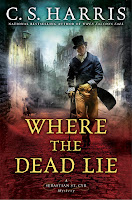After my last discussion of revisions,
Liz posed a question: How much of my hatred of revisions stems from the time constraints created by my publication deadlines? An interesting suggestion, and it prompted me to remember my attitude toward revisions before I started writing to contract.
In my experience, pre-published writers fall into one of two camps. In the one camp are those writers who dash off their manuscripts very quickly. They send them out, get rejected, toss the inadequate manuscript aside and start writing the next book idea. In the other camp are their opposites, the pre-pubs who take forever to write their first one or two or three manuscripts. They write a book, and then they rewrite it, over and over and over again.
Both tendencies have their plusses and minuses. The non-revisers have lots and lots of ideas churning around in their heads, clamoring to be written. Their ability to come up with saleable ideas matures as they learn what works and what doesn’t. But because they move on too quickly, they never learn to analyze their manuscripts and they never learn how to polish. Yes, they learn to put together better ideas, but they never learn from their WRITING mistakes. I know non-revisers who’ve produced more than a dozen manuscripts without selling one.
The revisers, on the other hand, learn to analyze what works and what doesn’t in their manuscripts; they learn how to rewrite, and how to fix problems. The downside is that their first book ideas are usually flawed at some basic level. They could spend a lifetime rewriting those manuscripts, but they would never be publishable because their basic idea was, well, flawed.
I understand it is really, really hard to walk away from a manuscript you’ve been revising for years. “But I’ve invested all those years in it! I know I can make it work. I understand the process now.” To these writers I say, “Great. Now take what you’ve learned and apply it to a fresh, new idea.”
That can be scary. The trick is not to become too wedded to any one book idea. Keep a “plot idea book” where you jot down conflicts and character sketches for future books. Force yourself to turn your back on your darlings and learn to love again. Tell yourself you can always come back to your first or second or third born in another year and rewrite it again, if you still want to. But move on.
So by now you’re probably wondering, Which category did I fall into before I was published? I was a reviser. I revised my first two books to death. I turned a sweet Regency into a sexy historical. I turned my dashing villain into the hero and made my dull old hero the foil. I wrote a contemporary suspense, then changed the plot line, the characters, the inciting incident; I rewrote the first chapters so many times I barely remember the original beginning. I started a new historical romance, about a convent-bred orphan who inherits a whorehouse in a Colorado mining town, and rewrote it to death, too. I spent eight years rewriting the same damn three books. It was only when I moved on and started the manuscript that became NIGHT IN EDEN that I finally sold a book—and the only thing I had to revise was the ending (I personally liked my originally ending better). I then revised the Colorado whorehouse book (THE BEQUEST) and sold it, too. I have at various times had publishers willing to buy the first two manuscripts, but only with so many changes that I knew it wasn’t worth it—I could write an entirely new, better, book in the same time. I said, No, thanks.
So, given my history, why do I now hate revisions? I think I kept revising when I first started writing for all the usual reasons. My first manuscripts were so precious to me, I couldn’t bear the thought of them not being published. But I suspect I also did it because it seemed easier to rewrite than to come up with an entirely new book idea. Now I have more ideas churning around in my head than I have time to write.
I suspect Liz is right: the time constraint now adds tremendous pressure. Trying to write two books a year, do the kind of self-promotion publishers demand, take care of two daughters and an aged mother, rebuild a hurricane-devastated house, and still keep myself healthy and sane is not easy. Finally making that first sale is nice (okay, it’s HEAVEN); but my writing income is now a critical part of the family budget, which means that a lot rides on every book. And the revision process, coming at the end when the time crunch is on and I’m forced to confront all my manuscript’s weaknesses, is never a good time.
On another front: If you’ve been following my car saga, the slow boat from Germany has finally—allegedly—docked. I could have had a silver or a gray months ago, but I wanted red, with a sunroof. And I should have it on Saturday. Do you know how many months it’s now been since my little Golf drowned? I am deliriously happy. So is everyone who’s been driving me around for the last six months!









